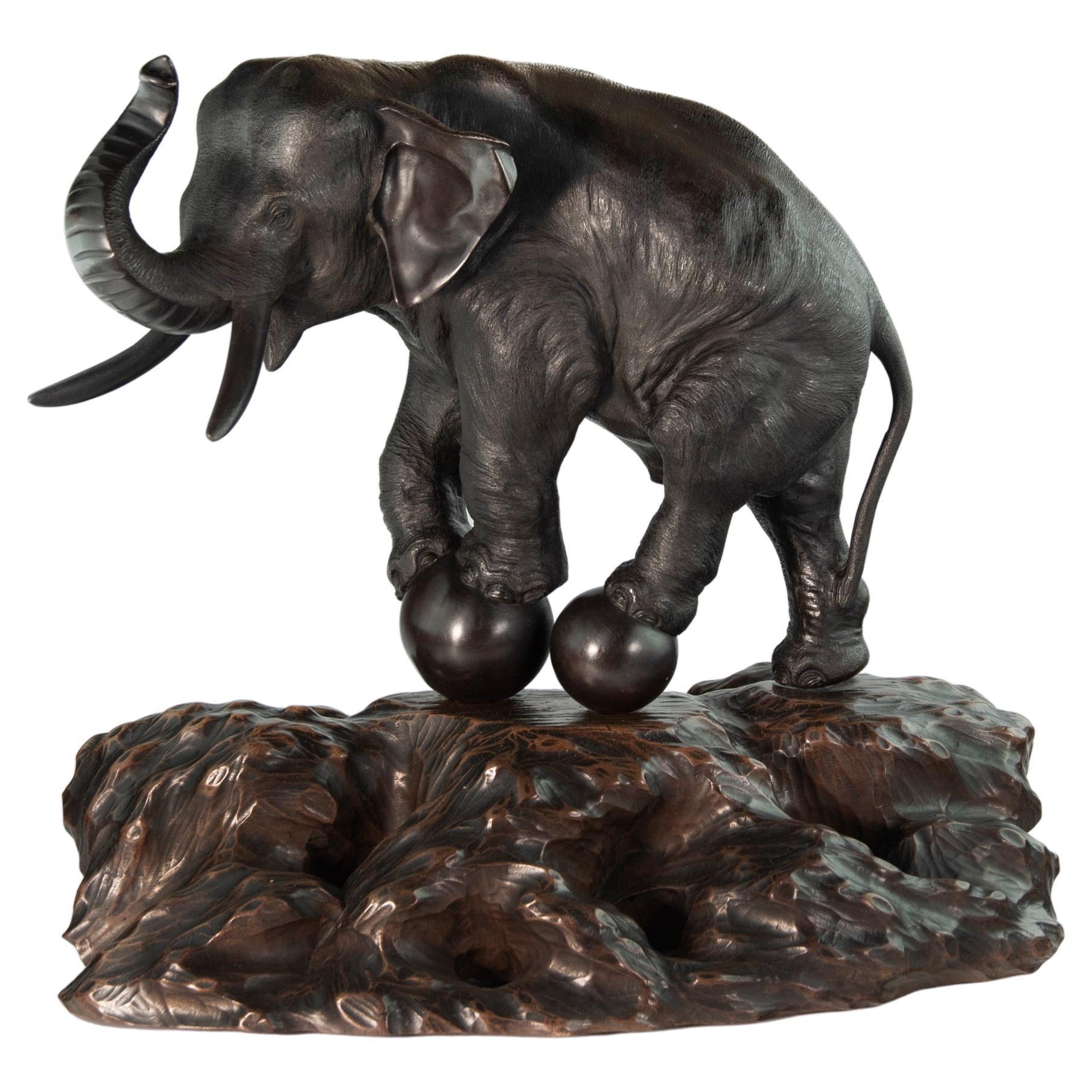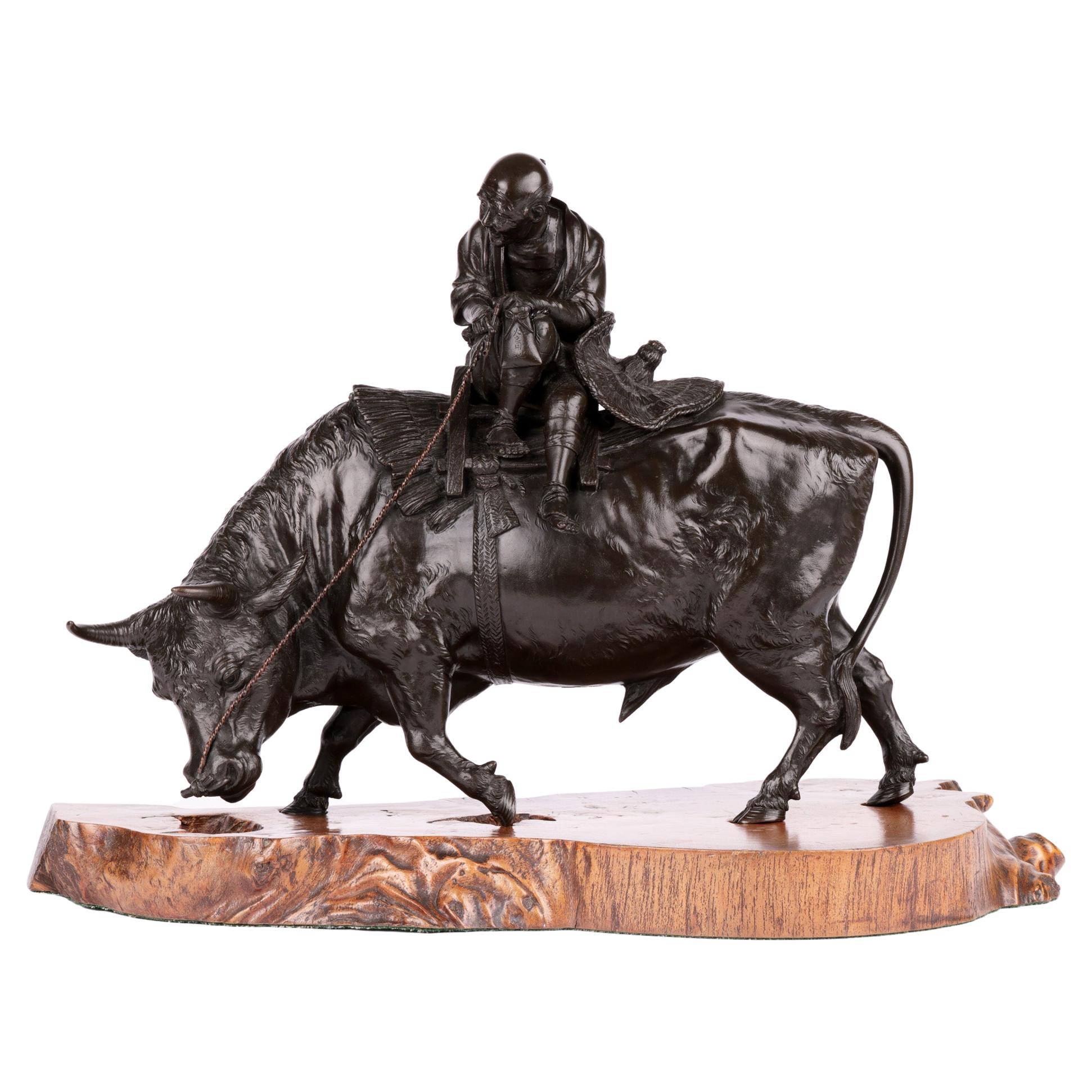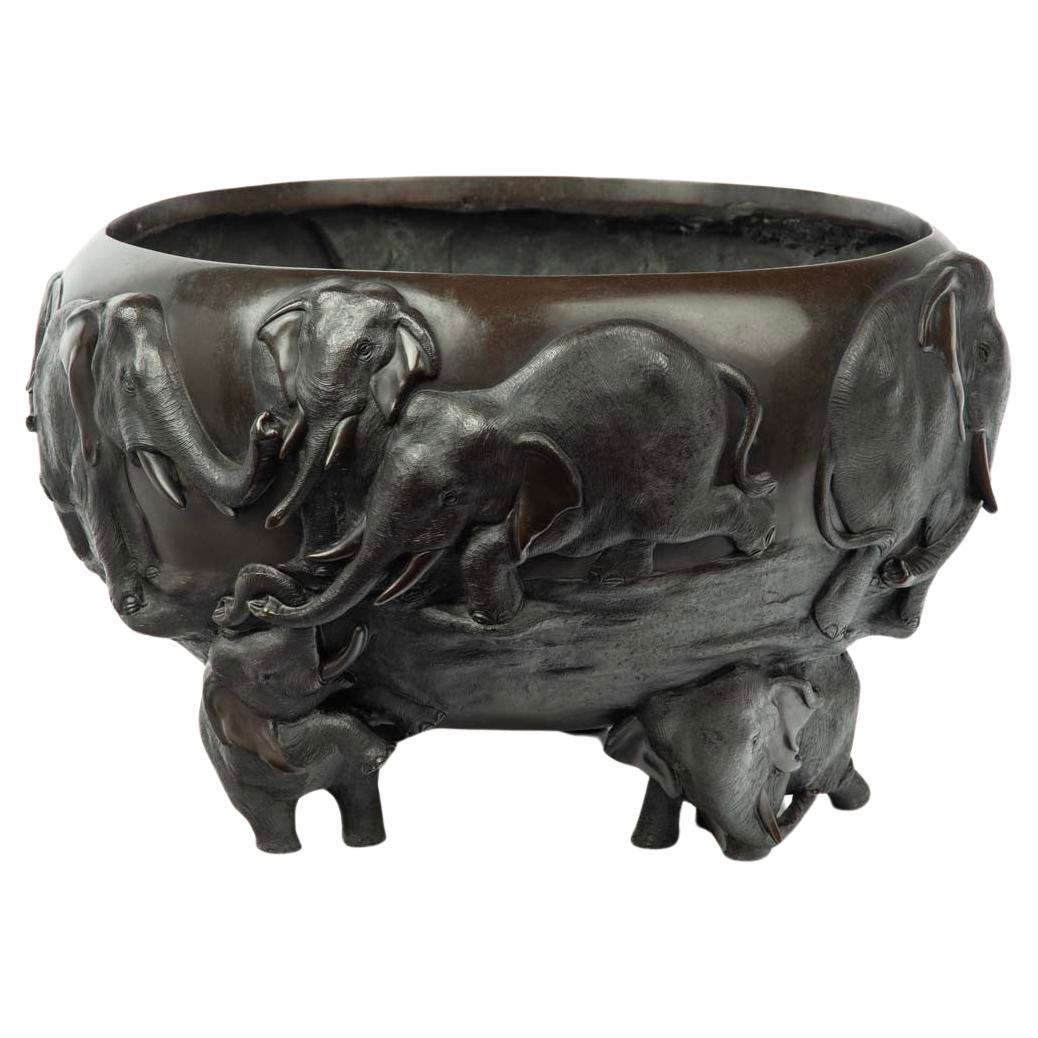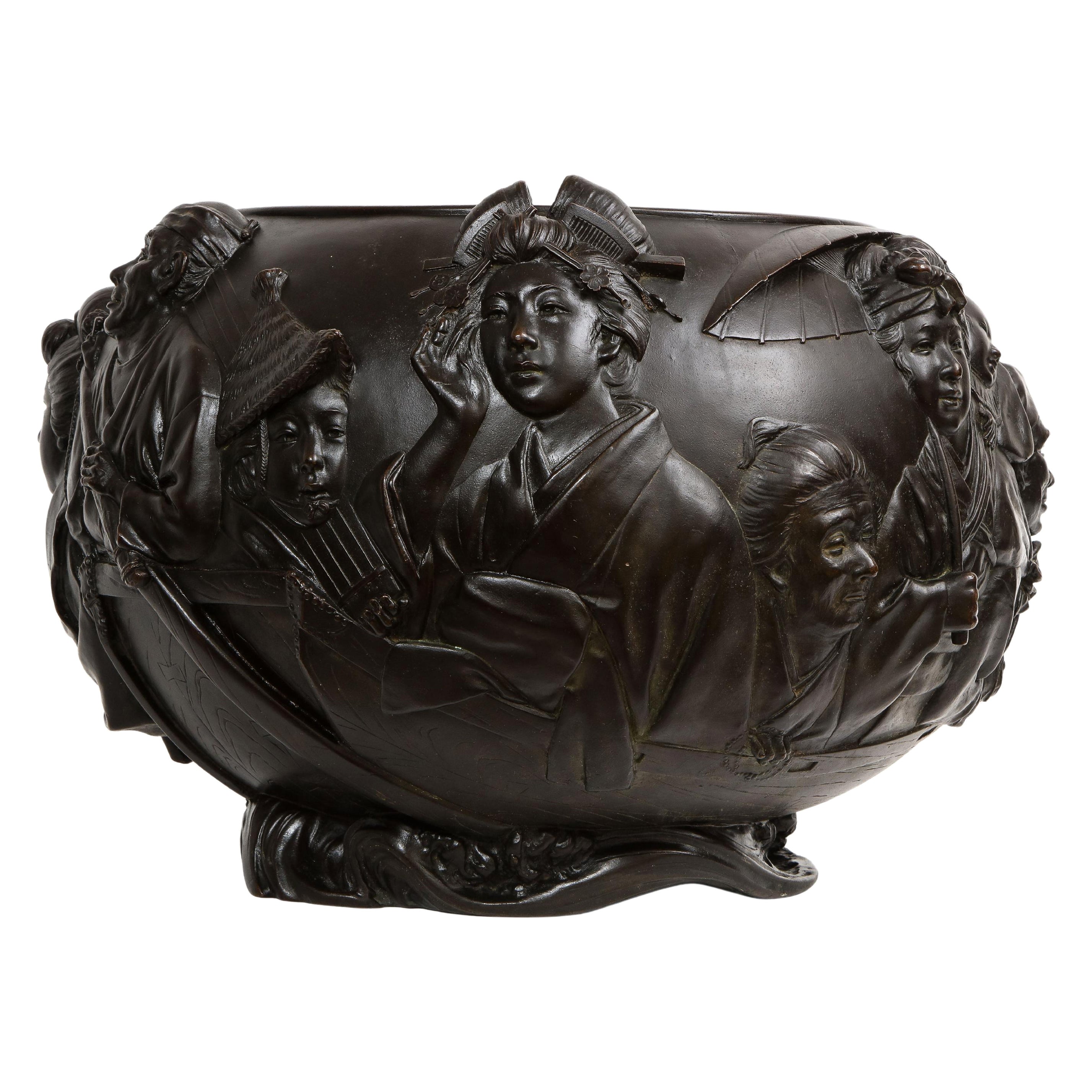Items Similar to Japanese Bronze Pheasant Okimono Genryusai Seiya
Want more images or videos?
Request additional images or videos from the seller
1 of 18
Japanese Bronze Pheasant Okimono Genryusai Seiya
About the Item
Unusual Casting of a Pheasant in Flight
From our Japanese collection, we are delighted to offer this Japanese bronze okimono of a Pheasant upon a naturalistic root wood base. The Pheasant cast from bronze with gilded feathers standing seconds before taking flight. With an extreme attention to detail Seyia has captured a stunning representation of the male pheasant with intricate detailing from the bill to the claws. Signed under the belly within a square tablet, Genryusai Seiya 源龍斎誠谷造. The Bronze Okimono dates to the Meiji Period (1868-1912) circa 1890.
Genryusai Seiya is one of the most celebrated Japanese bronze artists of the Meiji period. His workshop specialised in export wares of supreme quality, including animals, vases, and human figures. Most commonly Seiya bronzes can be seen as tigers and elephants often in single form or small groups. Renowned for his attention to detail, Seiya manages to encapsulate a natural and realistic look to every figure that has you checking twice to see if it is indeed a sculpture.
Meiji Period was an era of Japanese history that spanned from 1868 to 1912. It was the first half of the Empire of Japan, when the Japanese people began to build a paradigm of a modern, industrialised nation state and emergent great power, influenced by Western countries and aesthetics. As a result of radically different ideas, the changes to Japan were profound and it affected the social structure, politics, economy, military, and foreign relations across the board. The period corresponded to the reign of Emperor Meiji and was preceded by the Keio era and was succeeded by the Taisho era.
Cultural Art during the Meiji Period was of particular interest to the government and they overhauled the art export market which in turn promoted Japanese arts via various world’s fairs, beginning in Vienna at the world fair in 1873. The government heavily funded the fairs and took an active role organising how Japan’s culture was presented to the world including creating a semi-public company named Kiritsu Kosho Kaisha (First Industrial Manufacturing Company). The Kiritsu Kosho Kaisha was used to promote and commercialise exports of Japanese art and established the Hakurankai Jimukyoku (Exhibition Bureau) to maintain quality standards. For the 1876 Centennial International Exhibition in Philadelphia, the Japanese government created a Centennial Office and sent a special envoy to secure space for the 30,000 items that would be displayed. The Imperial Household also took an active interest in arts and crafts, commissioning works by select artists to be given as gifts for foreign dignitaries further emphasising the high quality and importance of Japanese art. Just before the end of the 19th century in 1890, the Teishitsu Gigeiin (Artist to the Imperial Household) system was created to recognise distinguished artists. These artists were selected for their exceptionally high quality wares and talent in their own industry. Over a period of 54 years Seventy artists were appointed, amongst these were ceramicist Makuzu Kozan and cloisonné enamel artist Namikawa Yasuyuki.
Measurements (centimetres) 46cm High x 46cm Wide x 25cm Deep inc. Base
- Creator:Genryusai Seiya (Sculptor)
- Dimensions:Height: 18.1 in (45.98 cm)Width: 18.1 in (45.98 cm)Depth: 9.8 in (24.9 cm)
- Style:Meiji (Of the Period)
- Materials and Techniques:
- Place of Origin:
- Period:
- Date of Manufacture:Circa 1890
- Condition:Wear consistent with age and use.
- Seller Location:Newark, GB
- Reference Number:
About the Seller
5.0
Vetted Seller
These experienced sellers undergo a comprehensive evaluation by our team of in-house experts.
Established in 2019
1stDibs seller since 2022
17 sales on 1stDibs
Typical response time: 3 hours
- ShippingRetrieving quote...Ships From: Newark, United Kingdom
- Return PolicyA return for this item may be initiated within 14 days of delivery.
More From This SellerView All
- Japanese Meiji Period Carved Wood Okimono Man with RabbitsLocated in Newark, EnglandThe charming figure, carved from a single piece of wood is exceptionally carved showing the male figure with humorous expression holding two Rabbits one by the ears and the second under his arm. A third Rabbit stands at the feet of the male looking up, each rabbit with a different expression. The male figure is wearing traditional Japanese attire with his hair tied back stood upon a naturalistic base. The figure dates to the Meiji Period (1868-1912) circa 1900. Notes The Rabbit is one of the 12 animals to feature in the Japanese Zodiac signs which follows the Chinese astrological system along with the Rat, Ox, Tiger, Rabbit, Dragon, Snake, Horse, Goat, Monkey, Rooster, Dog, Pig. Such division is connected with the Jupiter cycle around the Sun, which lasts about 12 years. As 2023 is the year of the Rabbit...Category
Antique Early 1900s Japanese Meiji Sculptures and Carvings
MaterialsWood
- Japanese Bronze Torii Gate Sculpture Meiji PeriodLocated in Newark, EnglandBeautifully sculpted Japanese Meiji period Torii gate sculpture. The sculpture made from solid bronze with a beautiful patination throughout dating to the Meiji period 1868-1912 circa 1890. The gate of traditional form representing the Matsuo Shrine in Kyoto. The characters read ???? translated directly to Matsuo Shrine. Notes The Torii gate sculpture was crafted after the famous Torii gate which is found in the Arashiyama district in Kyoto. It houses Matsuno’o Taisha (Matsunoo Taisha ????) one of the oldest shinto shrines in Kyoto dating to 701, approximately 100 years before the city of Kyoto. It boarders the mountains and has a distinct main hall dating to 1397 which is also one of the oldest buildings in the city of Tokyo. The shrine’s spring is famous for its restorative properties and sake and miso producer’s patron the shrine with their particular industries relying on the pure water to survive. The distinct giant Torri gate stands at 14 meters tall alluding to its significance in the city. Three beautiful gardens can...Category
Antique Late 19th Century Japanese Meiji Sculptures and Carvings
MaterialsBronze
- Japanese Skeleton Boxwood Netsuke Late Edo PeriodLocated in Newark, EnglandJapanese boxwood netsuke depicting a skeleton. The skeleton naturalistically carved in the foetal position in preparation for transitional burial. With...Category
Antique Mid-19th Century Japanese Edo Sculptures and Carvings
MaterialsWood, Boxwood
- German Memento Mori Carved SkullLocated in Newark, EnglandAntique 18th century fruitwood carved Memento Mori Skull. The skull of petrified display powerfully carved in the form of a human skull consisting of the cranium, upper and lower jaws, the cadaverous face with deliberate missing tooth in brown wash patination throughout. Stood upon a small marble base with the skull attaching via a dowel fitting. The Skull probably from German origin. Notes From approximately the sixteenth century, skulls were commonly used to remember death as they symbolise the transience of human life. Memento Mori literal Latin translation means remember that you [have to] die. The concept has its roots in the philosophers of classical antiquity, and appeared in funeral art and architecture of the medieval period. Memento Mori jewellery...Category
Antique 18th Century German Gothic Mounted Objects
MaterialsMarble
- Japanese Bronze Bottle Vase Takeuchi SeiBy Takeuchi ChubeiLocated in Newark, EnglandExceptional Japanese Meiji period bronze bottle vase. The vase of squashed globular form with a long stem neck and rounded rim. Boldly decorated throughout the entire exterior with raised blossoming flowers stood in a woven basket. To the opposing side a Japanese wave...Category
Antique Late 19th Century Japanese Meiji Metalwork
MaterialsMetal, Bronze
- Japanese Bronze Vase Pair Meiji PeriodLocated in Newark, EnglandA fine large sized pair of Japanese bronze vases. The vases each surmounted by waisted necks flanked by two spreading handles with accents in the form of Japanese Torri (traditional ...Category
Antique Late 19th Century Japanese Meiji Metalwork
MaterialsMetal, Gold, Silver, Bronze, Copper
You May Also Like
- Large Japanese Bronze Monkey Okimono – Genryusai SeiyaLocated in Christchurch, GBAs part of our Japanese works of art collection we are delighted to offer this large scale Meiji period (1868-1912) majestic bronze okimono group depicting an adult monkey at full st...Category
Antique 19th Century Japanese Meiji Sculptures and Carvings
MaterialsBronze
- Large Japanese Bronze Elephant Okimono - Genryusai SeiyaLocated in Christchurch, GBAs part of our Japanese works of art collection we are delighted to offer this unusual Meiji Period 1868-1912 , study of a large elephant performing a balancing act upon two huge bro...Category
Antique 19th Century Japanese Meiji Metalwork
MaterialsBronze
- Genryusai Seiya Japanese Meiji Man & Water Buffalo Sculpture on StandLocated in Bishop's Stortford, HertfordshireAn exceptional Japanese Meiji bronze sculpture of a man and water buffalo on a natural polished oak stand by renowned Japanese master craftsman Genryusai Seiya and dating from around 1880/90. The large bronze depicts an elderly man holding a pipe and tobacco pouch...Category
Antique 1880s Japanese Anglo-Japanese Sculptures and Carvings
MaterialsBronze
- Large Japanese Bronze Elephant Jardiniere - Genryusai SeiyaLocated in Christchurch, GBAs part of our Japanese works of art collection we are delighted to offer this large scale Meiji Period (1868-1912), cast bronze Jardiniere by the highly regarded foundry of Genryusa...Category
Antique 19th Century Japanese Meiji Metalwork
MaterialsBronze
- Okimono - Bronze Sculpture by Genryusai Seiya, Japan Meiji EraLocated in Saverne, Grand EstSuperb bronze okimono with dark brown patina representing a lady holding a gourd in her left hand. Signed Seiya Sei (made by Seiya). Genryusai Seiya was a master craftsman specializi...Category
Antique Late 19th Century Japanese Meiji Metalwork
MaterialsBronze
- Meiji Japanese Bronze Jardinière Japanese People on a Boat, Genryusai Seiya ZoLocated in New York, NYA masterpiece, rare, 19th Century Japanese bronze Jardinière/centerpiece of a group of Japanese travelers on a boat, signed on the bottom, Genryusai Seiya...Category
Antique Early 1900s Japanese Meiji Metalwork
MaterialsBronze
Recently Viewed
View AllMore Ways To Browse
Japanese Meiji Figure
Asian Plinth
Chinese Buddhism
Buddha Set
Parrot Carvings
Japanese And Chinese Boxes
Antique Clay Buddha
Jade Citron
Dragon Hanging Japanese
Chinese Bronze Hand Warmer
Amita Bul
Big Paper Lantern
Dancing Demon Made Of Wood
Carved Wood Indonesian Lions
Architectural Temple
Small Chinese Carving
Ainu Bear Wood
Wooden Shan Buddha





